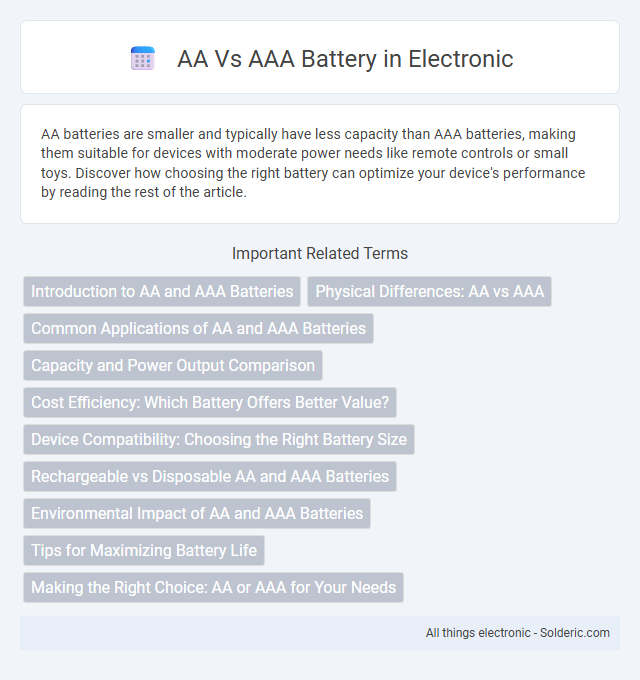AA batteries are smaller and typically have less capacity than AAA batteries, making them suitable for devices with moderate power needs like remote controls or small toys. Discover how choosing the right battery can optimize your device's performance by reading the rest of the article.
Comparison Table
| Feature | AA Battery | AAA Battery |
|---|---|---|
| Size | 50.5 mm x 14.5 mm | 44.5 mm x 10.5 mm |
| Weight | Approx. 23 g | Approx. 11.5 g |
| Voltage | 1.5 V (standard alkaline) | 1.5 V (standard alkaline) |
| Capacity | 1800-2800 mAh (alkaline) | 800-1200 mAh (alkaline) |
| Common Usage | Remote controls, flashlights, cameras | TV remotes, wireless mice, small electronics |
| Cost | Generally higher due to size | Generally lower due to smaller size |
Introduction to AA and AAA Batteries
AA and AAA batteries are among the most common cylindrical cells used to power various electronic devices. AA batteries typically have a diameter of 14.5 mm and a length of 50.5 mm, offering higher capacity and longer runtime compared to AAA batteries, which measure 10.5 mm in diameter and 44.5 mm in length. Your choice between AA and AAA batteries depends on the device's size constraints and power requirements, with AA batteries favored for higher-drain devices and AAA batteries suited for smaller electronics.
Physical Differences: AA vs AAA
AA batteries are larger in both length and diameter, typically measuring about 50.5 mm in length and 14.5 mm in diameter, whereas AAA batteries are smaller, measuring around 44.5 mm in length and 10.5 mm in diameter. The physical size difference significantly impacts their energy capacity, with AA batteries generally holding more charge due to their larger volume. Devices requiring compact design or lower power consumption often utilize AAA batteries, while AA batteries are preferred for higher power demands.
Common Applications of AA and AAA Batteries
AA batteries are widely used in medium-drain devices like remote controls, digital cameras, and handheld gaming consoles due to their higher capacity and longer runtime. AAA batteries, being smaller and lighter, are preferred for low-drain devices such as wireless keyboards, computer mice, and small flashlights, offering compact power solutions. Your choice between AA and AAA batteries depends on the device's power requirements and size constraints to ensure optimal performance.
Capacity and Power Output Comparison
AA batteries typically offer higher capacity, ranging from 2000 to 3000 mAh, compared to AAA batteries, which usually have capacities between 600 and 1200 mAh. The larger size of AA cells enables greater power output, making them suitable for devices requiring more energy over extended periods. Choosing AA or AAA batteries depends on the power demands of Your device, with AA providing longer runtime and higher current supply.
Cost Efficiency: Which Battery Offers Better Value?
AA batteries generally offer better cost efficiency compared to AAA batteries due to their larger capacity and longer lifespan, which means you get more energy output per dollar spent. While AAA batteries are smaller and often used in compact devices, their higher frequency of replacement can increase overall costs. Choosing AA batteries can maximize your value, especially for high-drain electronics, by reducing the number of purchases and waste over time.
Device Compatibility: Choosing the Right Battery Size
AA batteries are commonly used in medium-drain devices like remote controls, digital cameras, and wireless keyboards, while AAA batteries are preferred for smaller gadgets such as TV remotes, calculators, and small flashlights due to their compact size. Your choice between AA and AAA should depend on the device's battery compartment specifications and power requirements to ensure optimal performance and longevity. Selecting the correct battery size enhances device compatibility and prevents potential damage or malfunction.
Rechargeable vs Disposable AA and AAA Batteries
Rechargeable AA and AAA batteries offer long-term cost savings and environmental benefits compared to disposable versions, as they can be recharged hundreds of times before replacement. Disposable AA and AAA batteries provide convenience for occasional use, but their limited lifespan generates more waste and higher costs over time. For devices with frequent use, choosing rechargeable AA or AAA batteries optimizes performance and sustainability for your power needs.
Environmental Impact of AA and AAA Batteries
AA and AAA batteries differ in size but share similar environmental impacts due to the chemicals and heavy metals they contain, which can harm soil and water if not recycled properly. Proper disposal and recycling of these batteries help minimize toxic waste and reduce the demand for raw material extraction, preserving natural resources. You can reduce your environmental footprint by choosing rechargeable AA or AAA batteries to limit single-use battery waste.
Tips for Maximizing Battery Life
To maximize battery life in AA and AAA batteries, use devices with low power consumption and turn them off when not in use. Store batteries in a cool, dry place to prevent leakage and degradation, and avoid mixing old and new batteries or different brands. Using rechargeable batteries and chargers designed specifically for AA and AAA types can also extend overall battery lifespan and reduce waste.
Making the Right Choice: AA or AAA for Your Needs
Choosing between AA and AAA batteries depends on device power requirements and size constraints; AA batteries offer higher capacity and longer runtime, making them ideal for power-hungry devices like digital cameras and gaming controllers. AAA batteries, being smaller and lighter, suit low-drain gadgets such as remote controls and wireless mice, providing convenience without sacrificing portability. Evaluating the device's dimensions and energy consumption helps determine the optimal battery type for efficient and cost-effective operation.
AA vs AAA battery Infographic

 solderic.com
solderic.com